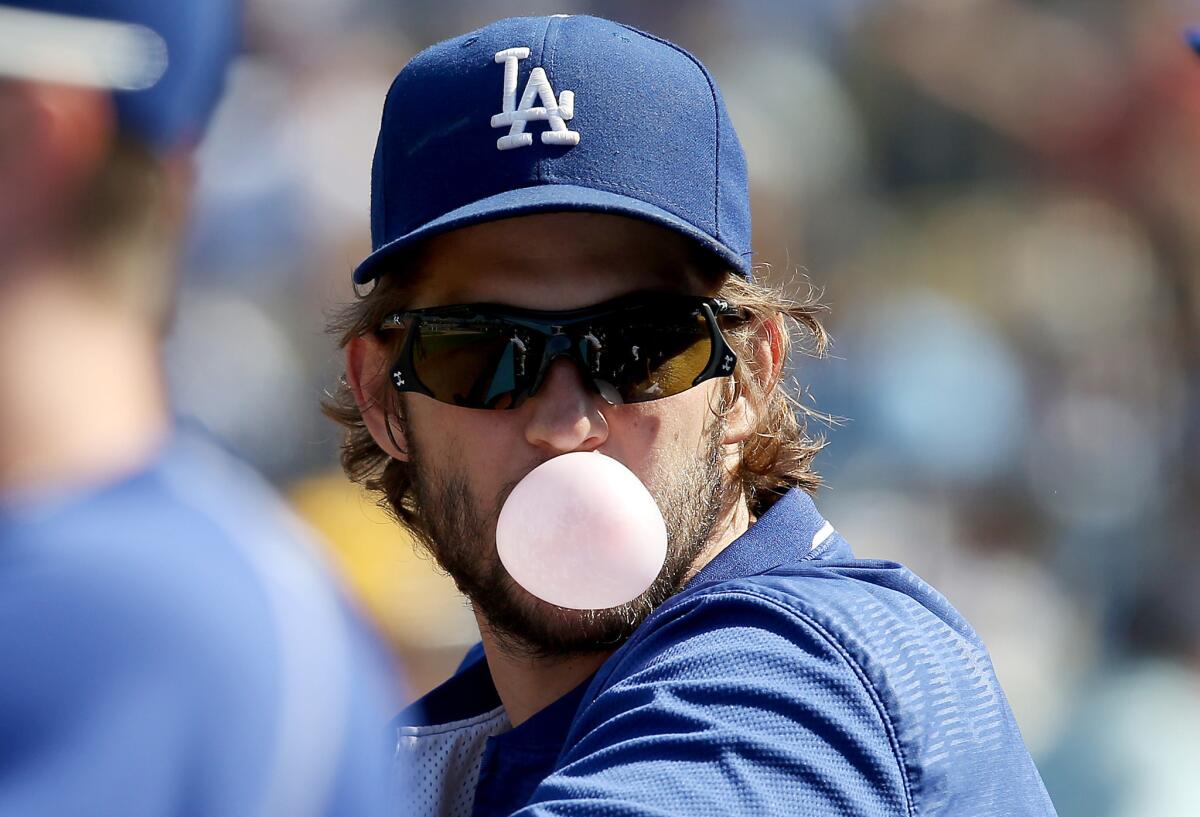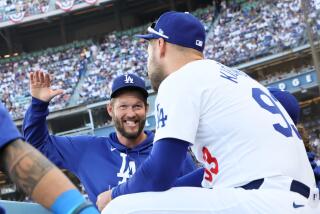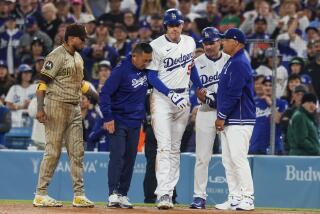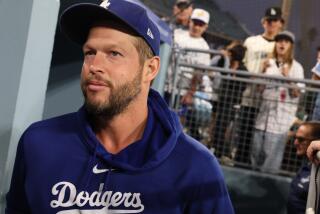Dodgers cross fingers, dream about October as Clayton Kershaw returns this weekend

- Share via
Reporting from MIAMI — The subsequent months have sanded away the details of his dejection. Dave Roberts cannot recall whether he read the message in a text or listened to Dodgers president of baseball operations Andrew Friedman speak the words aloud. But he can still recall their meaning.
“We’ve got some bad news,” Friedman told the manager July 17. Roberts was with his team in Arizona, preparing for Clayton Kershaw to rejoin the club days later in Washington. Kershaw would not be boarding a plane bound for the East Coast, Roberts learned. He had experienced a recurrence of pain caused by the herniated disk in his lower back. There was no timetable for his return.
“It was definitely deflating,” Roberts said.
The setback could have served as a seismic shock to the organization. Kershaw had acted as Atlas during the first three months of 2016. But how the organization and Kershaw responded in July and August set the stage for Friday at Marlins Park, when he will return to a big league mound for the first time since June.
As Kershaw concentrated on physical therapy, the Dodgers fashioned themselves into a playoff contender. The offense took flight. The starting rotation found stability in a strategy that looked like chaos. Roberts oversaw a clubhouse that impressed him with its professionalism and unity.
As the Dodgers pulled ahead of San Francisco last month, Kershaw reshaped his habits in deference to his new physical reality. He declined to rush back. He huddled with the team’s medical and training staffs to prepare him for a gasp at greatness in the season’s final weeks, when he might reclaim his place as the ace of a team with championship aspirations.
“It’s almost like we just traded for the best pitcher in baseball in September,” third baseman Justin Turner said.
The Dodgers (79-60) enter this weekend in their most comfortable position all season. Winners of five in a row, they lead the National League West by five games. Acquired at the deadline and sidetracked by blisters, Rich Hill has dominated in his two starts. Another left-handed menace will now join him in the rotation.
The Dodgers do not know what to expect in Miami. They do not know how Kershaw’s back will respond after he pitches. But they understand how even a limited version of Kershaw can elevate their ceiling. He is unlikely to throw more than five innings Friday. He will be monitored with care throughout the process, but Roberts expects to keep a tight leash on Kershaw during his first three outings. If his body responds, he still won’t be let loose until October.
“The reason he’s coming back is for the postseason,” Roberts said.
During the final week of June, after posting an 11-2 record and a 1.79 earned-run average in 16 starts, Kershaw left the team in Milwaukee to head to Los Angeles. Robert Watkins, the team’s back specialist, administered a pain-killing epidural injection.
Turner approached Kershaw when he heard the news. He offered condolences and a promise. When you come back, Turner told him, you’re going to come back to a better team.
The Dodgers upheld their end of the bargain. The team has a record of 38-24 since Kershaw went on the disabled list. Unlike 2015,when Kershaw and Zack Greinke dragged the team into the playoffs, the offense is filled with healthy players capable of punishing opposing pitchers. Four members of the starting lineup — Turner, Corey Seager, Yasmani Grandal and Joc Pederson — have hit 20 homers or more, and Adrian Gonzalez has hit 17.
“We’re a scary team,” Roberts said.
To fill the void in the starting rotation, the Dodgers utilized an unorthodox but effective strategy. Leaning on its farm system, the team shuttled starters and relievers back and forth from the 25-man roster, somehow flourishing despite receiving an average of only five innings a game from starters.
The depth provided time for Hill’s blisters to heal. It also allowed the team to use rookie Kenta Maeda on five days’ rest, as he did during his career in Japan. The situation seemed laughable on the surface — a team with one reliable starting pitcher, who works a Japanese schedule — but the results are difficult to argue.
Kershaw toiled under the care of physical therapist Stephen Smith, who helped him strengthen his back and core muscles so his body could handle the strain of his workload. Kershaw does not just tax his body on the mound. He punishes himself in between outings to create reserves of energy.
Friedman described Kershaw as “extremely routine-oriented,” an ace who dislikes deviation from his five-day schedule. When Kershaw hears a suggestion about altering his program, strength and conditioning coach Brandon McDaniel explained, he tables the discussion until the next off-season.
In this case, Kershaw understood the necessity of change. Team officials described him as open to suggestion and willing to be creative. Kershaw drove the discussion, Friedman said.
“He’s been able to think through what will allow him to achieve very similar results in a slightly different way,” Friedman said.
In deference to Kershaw’s interest in privacy, team officials kept quiet about the details of the alterations. What mattered, they emphasized, was he was still capable of completing the tasks necessary to return.
Kershaw maintained a program to strengthen his left shoulder. He was cleared to run in August, which allowed Kershaw to resume a vital part of his conditioning. McDaniel described the necessity of being more efficient in the workouts and “adding in some things that cleaned up some movement patterns.”
“I really wouldn’t say that he’s doing that much different,” McDaniel said. “There are some things that obviously we can’t do. I don’t think Kersh is going to go jump off a 10-foot box any time soon, but he wasn’t doing that before.”
For now, the team feels confident that he is capable of performing at a high level. As the years pass, Friedman explained, both the Dodgers and Kershaw will have a better sense of how to manage his workload to keep him healthy.
The initial disk herniation does not necessarily foretell a future of further injury, according to Andrew Hecht, the chief of spinal surgery for Mount Sinai Health System and Mount Sinai Hospital in New York. Hecht said the “overwhelming majority” of athletes he treats for herniated disk avoid surgery and return to action.
“Could he become symptomatic again? Well, anything is possible,” Hecht said. “But it’s a very promising thing that he’s now throwing without pain, pitching in simulated games and now getting ready to return.”
Earlier this week, Roberts watched video of Kershaw’s rehabilitation outing with Class-A Rancho Cucamonga. The curveball looked shaky, a reasonable outcome after months without usage. But his fastball velocity encouraged Roberts. The slider darted and bit. He looked, Roberts said, “like Clayton Kershaw.”
On Tuesday afternoon, Kershaw trotted into the bullpen in left field at Dodger Stadium and completed his usual throwing to prepare for a start. He can be hyper-critical of himself, which made his reaction to this session so surprising. He burst into a smile.
“Actually, good,” Kershaw said. “I actually feel all right.”
Kershaw turned away from his locker and headed for the clubhouse exit.
“We’ll see. We’ll find out Friday.”
Go to latimes.com/sports on Friday for a live, in-game blog following Clayton Kershaw’s progress in his return start against the Miami Marlins.
Twitter: @McCulloughTimes
More to Read
Are you a true-blue fan?
Get our Dodgers Dugout newsletter for insights, news and much more.
You may occasionally receive promotional content from the Los Angeles Times.









